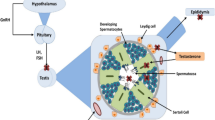Abstract
Objectives. The paper presents results of collaborative research on cadmium as an endocrine disruptor. To detect steroidogenic alterations in cycling and pregnant rats following cadmium exposures in vivo (at 3 or 5 mg/kg as a single s.c. dose) and in vitro (from 0 through 2,000 µM Cd2+) whole-ovary culture was used. To evaluate steroid productions in rats fed low iron (10 ppm) and concomitantly exposed to cadmium (5 mg/kg total dose by s.c.-implanted osmotic pumps) during 19 days of pregnancy whole-placenta culture was also used. In human placental tissue cadmium and progesterone concentrations were assessed in relation to cigarette smoking.
Methods. Cultures of minced ovaries were evaluated for 1-h basal steroid production and following 1-h production stimulated with either human chorionic gonadotropin (hCG) or hCG and pregnenolone. Placental cultures were evaluated for average 1-h progesterone production following 3 h of unstimulated production. Steroid hormones were evaluated by specific radioimmunoassay. Placental cadmium concentrations were analyzed by atomic absorption spectrometry.
Results. In-vivo cadmium exposure interfered with normal steroidogenesis in cycling rats and in early pregnancy, with ovarian estradiol production the most affected. Under in-vitro cadmium exposure the most affected was ovarian production of progesterone and testosterone in cycling (proestrous) rats with medial inhibitory concentrations under 500 µM Cd2+. Cadmium interfered with the steroidogenic pathway at more than one site. Linear and additive effects of low-iron feeding and concomitant cadmium exposure during pregnancy on placental progesterone production were found. In humans, we found that the placentas of smoking mothers contained twice as much cadmium and approximately half the amount of progesterone than did the placentas of non-smoking mothers.
Conclusions. Results of the research on cadmium-induced steroidogenic effects using cultures of whole rat ovary and/or placenta as well as human placental tissues point to cadmium as an endocrine disruptor that may compromise pregnancy outcome and fetal viability.
Similar content being viewed by others
Author information
Authors and Affiliations
Additional information
Electronic Publication
Rights and permissions
About this article
Cite this article
Piasek, M., Laskey, J.W., Kostial, K. et al. Assessment of steroid disruption using cultures of whole ovary and/or placenta in rat and in human placental tissue. Int Arch Occup Environ Health 75 (Suppl 1), 36–44 (2002). https://doi.org/10.1007/s00420-002-0351-3
Issue Date:
DOI: https://doi.org/10.1007/s00420-002-0351-3




